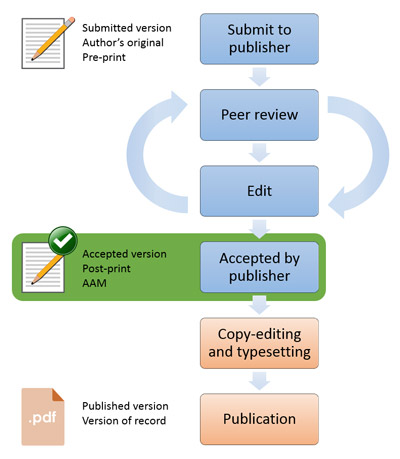Roughly 80 % of publishers allow self-archiving of some version of the article in open repositories and the most common version allowed is the accepted manuscript (post-print). For this reason, it is most important to keep a copy of the final manuscript which includes the modifications from peer review. The second part of the Think Open blog’s self-archiving series deals with the article versions.
 (Tämä artikkeli on saatavilla myös suomeksi.)
(Tämä artikkeli on saatavilla myös suomeksi.)
Many versions of a research article are generated during the publishing process. The usefulness of these versions for an open repository (e. g. University of Helsinki’s Helda repository) varies greatly.
The version of the article changes from the original manuscript submitted to the journal (pre-print) into the final draft version as a result of revisions from the peer review process (post-print). The final draft version, also known as the accepted manuscript, is the version best suited for open repositories.
The next version after the final draft is the proof version with publisher lay-out followed by the complete publisher PDF version. Normally these versions are not suitable for self-archiving in a repository, except in case of an OA journal or a hybrid article.
Restrictions on the use of certain article versions in repositories are due to publishers, and these policies are documented in SHERPA/RoMEO service. This service also contains information on embargo periods required by publishers.

Roughly 80 % of publishers allow self-archiving of some version of the article in open repositories and the most common version allowed is the accepted manuscript (post-print). For this reason, it is most important to keep a copy of the final manuscript which includes the modifications from peer review. The accepted manuscript is usually a Word or PDF file holding the same content as the published version but without the lay-out of the journal. The appearance of the manuscript may vary according to the submission system used by the publisher, and it may contain logos generated by this system.
It is most important to keep a copy of the final manuscript which includes the modifications from peer review.
What happens if the final manuscript cannot be found?
There is still hope. One may retrieve the accepted manuscript from the submission system of the publisher.
In order to submit the article to the journal the author needs to register in the publisher system (ia. ScholarOne, Editorial Manager, eJournalPress, Evise). By logging in the publisher system the author can download the accepted manuscript even after the article has been published. This last resort may help to retrieve the version of the article suitable for depositing in the digital repository.
There is some variation in the terms used for describing article versions. The table below presents these terms.
| Pre-print | Post-print | Publisher’s pdf | |
| Definition | Manuscript before submission. | Manuscript revised on the basis of peer review. Does not contain publisher lay-out or page numbers. | Final published version with journal lay-out. |
| Other terms |
submitted version, author-submitted article, pre-refereeing, author’s draft | final draft, accepted article, Author’s Accepted Manuscript (AAM), author’s post-print | publisher’s pdf, final published article, publisher’s version, Version of Record (VoR) |
| Deposit in TUHAT research information system? | Usually not deposited. | The version deposited if publisher pdf is not allowed. Most common version for self-archiving. | Used primarily if allowed by the publisher. |
Articles published in this series:
- Self-archiving is a free way for researchers to carry out open access publishing
- Which version of the article can I submit to the digital repository?
- Four small steps – how to publish your paper openly in Helda repository
- Better visibility, more impact – and six other advantages of self-archiving
- Support for self-archiving from the library
- Two-point checklist about self-archiving for University of Helsinki researchers
- How and why I self-archive – four researchers report their views
